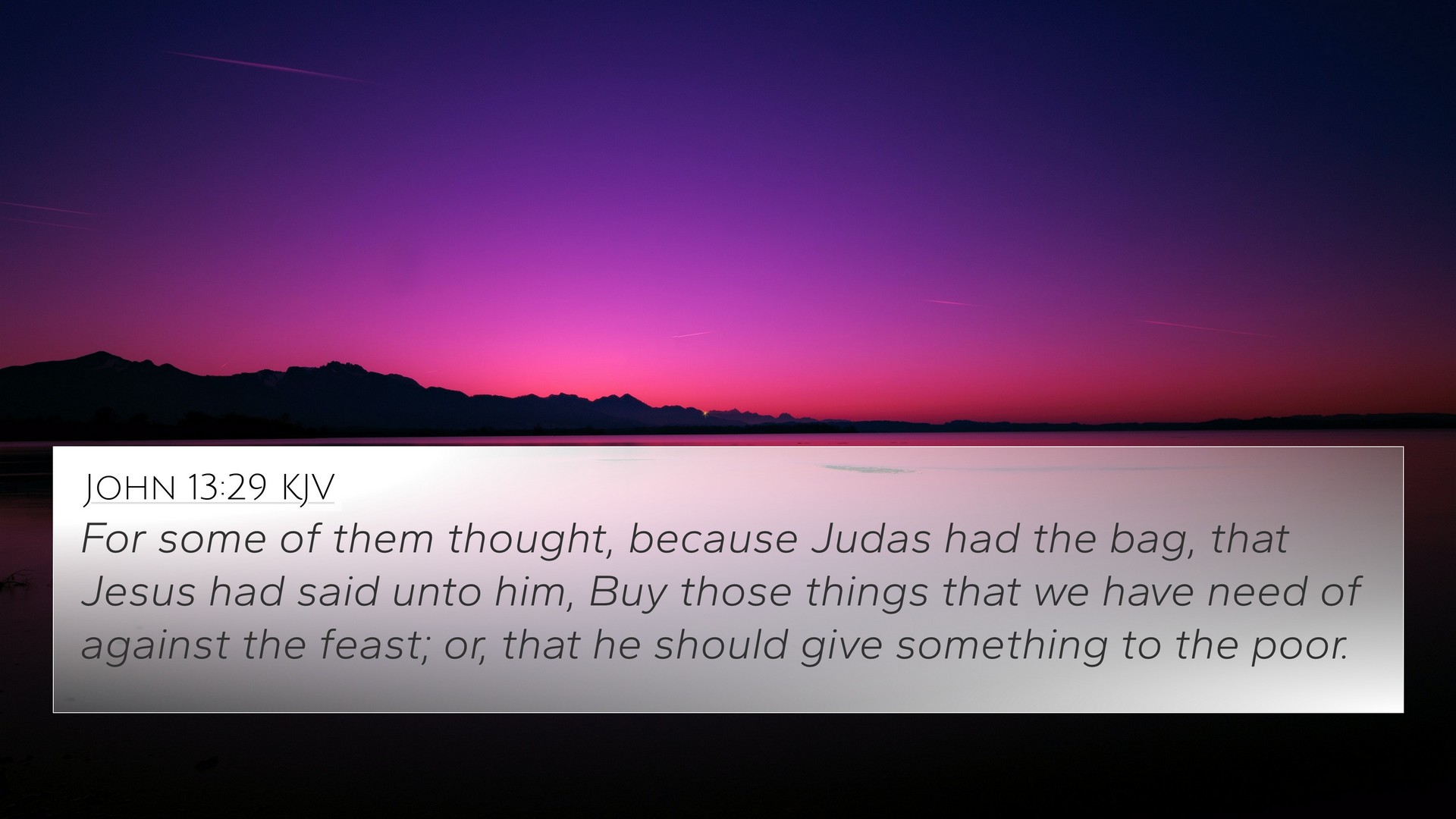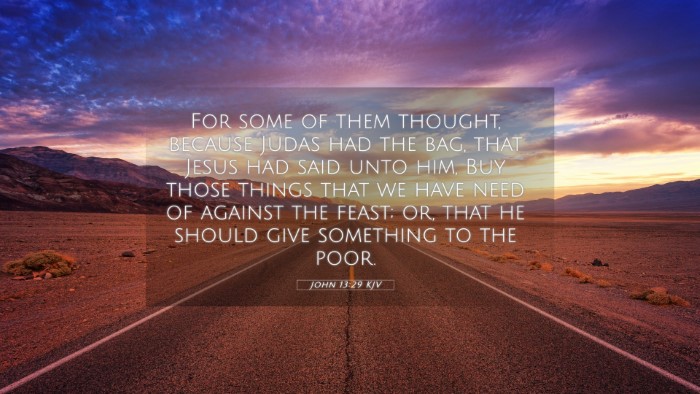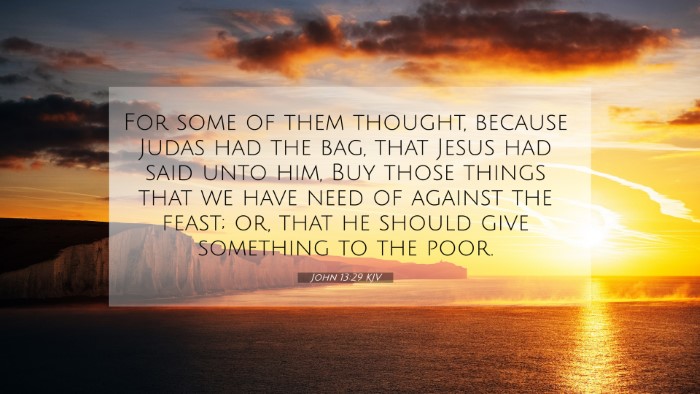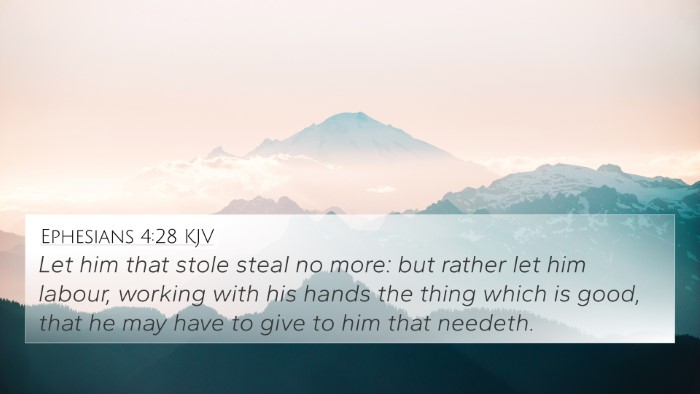Understanding John 13:29
John 13:29 states: "For some of them thought, because Judas had the bag, that Jesus had said unto him, Buy those things that we have need of against the feast; or, that he should give something to the poor." This verse occurs during the Last Supper, when Jesus reveals that one of His disciples would betray Him. The verse highlights the misunderstandings among the disciples concerning Jesus' instructions and the character of Judas Iscariot.
Insights from Commentaries
- Matthew Henry's Commentary:
Henry notes that the disciples were unaware of Judas's treachery, highlighting their innocence in the situation. Their assumption that Jesus instructed Judas to prepare for the feast or help the poor reflects their understanding of Jesus’s ministry as caring and benevolent.
- Albert Barnes' Notes:
Barnes emphasizes the significance of Judas being the treasurer. The disciples thought that Jesus was instructing Judas to buy provisions, demonstrating their naivety regarding Judas’s true intentions and character. This misunderstanding is a pivotal moment that showcases the prevalence of betrayal within proximity to holiness.
- Adam Clarke's Commentary:
Clarke provides context on the Passover meal and indicates that the disciples naturally inferred that Judas was to do something good. His focus on Judas’s actions and their implications underlines how even within a group called to follow Christ, evil can lurk undetected. Clarke points out that this speaks to both the innocence of the disciples and the cunning nature of Judas.
Thematic Analysis
This verse can be tied to several themes present in the Bible:
- Betrayal and Innocence: The scene does not just illustrate Judas's betrayal but contrasts it with the disciples' genuine misunderstanding.
- Provision and Poverty: The mention of providing for the poor reflects the social teachings of Jesus and the responsibilities of community.
- Misunderstanding Jesus' Teachings: This moment reveals how easily discipleship can lead to confusion, showing that followers may misinterpret the intentions of their leader.
Bible Cross-References
John 13:29 can be cross-referenced with the following verses to deepen understanding:
- Matthew 26:14-16: Judas's agreement to betray Jesus for thirty pieces of silver reveals his motives.
- John 12:4-6: Provides insight into Judas’s character and his fixation on money, highlighting his role as the treasurer.
- Luke 22:3-6: Offers further insight into Judas’s betrayal as a premeditated act.
- Mark 14:10-11: Confirms Judas's conspiracy with the chief priests to betray Jesus.
- John 13:21: Jesus states that one of the disciples would betray Him, setting the stage for the verse in question.
- Acts 1:16-20: Discusses the aftermath of Judas's betrayal and the subsequent need for his replacement among the apostles.
- John 6:70-71: Jesus forewarns about one of His disciples being a devil, thereby indicating that such betrayal was foreseen.
- Exodus 30:15: Discusses the poor and the provision in Israel, correlating with the disciples’ thought regarding helping the less fortunate.
- John 7:35: Raises questions about the dispersion of the disciples and speaks to their communal identity and purpose.
- Hebrews 10:24-25: Stresses the importance of community and support among believers, urging them not to neglect meeting together.
Connections Between Bible Verses
Exploring John 13:29 alongside its cross-references reveals the intricate tapestry of relationships in the scriptures:
- The betrayal of Judas connects various narratives underscoring the constant theme of loyalty and deceit among Jesus's followers.
- Linking this verse with Matthew 26, we see how betrayal poignantly culminates in decisive moments that define human relationships with God.
- Comparative analysis with Proverbs 14:15 emphasizes the naive nature of the disciples, reinforcing how discernment is pivotal in spiritual companionship.
- Examining the parallels with the Old Testament, one may note similar themes of treachery and leadership failures as seen in the stories of Kings.
Tools for Bible Cross-Referencing
For those studying John 13:29, various tools can enhance understanding:
- Bible Concordance: A comprehensive resource to find specific terms and their occurrences throughout scripture.
- Bible Cross-Reference Guide: A tool to aid in identifying connections across different verses based on themes and topics.
- Cross-Reference Bible Study: Engaging with scriptures through interconnected verses deepens theological understanding.
- How to Use Bible Cross-References: Techniques for effectively navigating through related verses to extract underlying meanings.
Conclusion
John 13:29 serves as a crucial pivot in the narrative leading to the crucifixion of Jesus, encapsulating themes of misunderstanding, betrayal, and the dynamics of communal life among His followers. By employing various biblical cross-references and utilizing tools for cross-referencing, believers can enrich their study and understanding of this profound verse.







